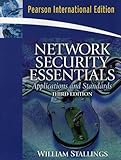Network security essentials : applications and standards / William Stallings.
Material type: TextPublication details: Upper Saddle River, NJ : Pearson Education, c2007.Edition: 3rd edDescription: xvi, 413 p. : ill. ; 24 cm; xvi, 413 p. : ill. ; 24 cmISBN:
TextPublication details: Upper Saddle River, NJ : Pearson Education, c2007.Edition: 3rd edDescription: xvi, 413 p. : ill. ; 24 cm; xvi, 413 p. : ill. ; 24 cmISBN: - 9780132303781
- 005.8 22
| Item type | Current library | Call number | Copy number | Status | Date due | Barcode | |
|---|---|---|---|---|---|---|---|
 Books
Books
|
Main library General Stacks | 005.8 / ST.N 2007 (Browse shelf(Opens below)) | 1 | Available | 008298 |
Browsing Main library shelves, Shelving location: General Stacks Close shelf browser (Hides shelf browser)

|

|

|

|

|

|

|
||
| 005.8 / ST.N 2003 Network security essentials : | 005.8 / ST.N 2003 Network security essentials : | 005.8 / ST.N 2003 Network security essentials : | 005.8 / ST.N 2007 Network security essentials : | 005.8 / ST.N 2011 Network security essentials : | 005.8 / ST.N 2011 Network security essentials : | 005.8 / TA.A 2009 Architecting secure software systems / |
Preface -- 1. Introduction -- 1.1 The OSI Security Architecture -- 1.2 Security Attacks -- 1.3 Security Services -- 1.4 Security Mechanisms -- 1.5 A Model for Internetwork Security -- 1.6 Internet Standards the Internet Society -- 1.7 Outline of This Book -- 1.8 Recommended Reading -- 1.9 Internet and Web Resources -- I. CRYPTOGRAPHY -- 2. Symmetric Encryption and Message Confidentiality -- 2.1 Symmetric Encryption Principles -- 2.2 Symmetric Encryption Algorithms -- 2.3 Cipher Block Modes of Operation -- 2.4 Location of Encryption Devices -- 2.5 Key Distribution -- 2.6 Recommended Reading and Web Sites -- 2.7 Key Terms, Review Questions, and Problems -- 3. Public-Key Cryptography and Message Authentication -- 3.1 Approaches to Message Authentication -- 3.2 Secure Hash Functions and HMAC .
3.3 Public Key Cryptography Principles -- 3.4 Public-Key Cryptography Algorithms -- 3.5 Digital Signatures -- 3.6 Key Management -- 3.7 Recommended Reading and Web Sites -- 3.8 Key Terms, Review Questions, and Problems -- Appendix 3A Prime Numbers and Modular Arithmetic -- II. NETWORK SECURITY APPLICATIONS -- 4. Authentication Applications -- 4.1 Kerberos -- 4.2 X.509 Directory Authentication Service -- 4.3 Public Key Infrastructure -- 4.4 Recommended Reading and Web Sites -- 4.4 Key Terms, Review Questions, and Problems -- Appendix 4A: Kerberos Encryption Techniques -- 5. Electronic Mail Securit -- 5.1 Pretty Good Privacy (PGP) -- 5.2 S/MIME -- 5.3 Recommended Web Sites -- 5.4 Key Terms, Review Questions, and Problems -- Appendix 5A: Data Compression Using ZIP -- Appendix 5B: Radix-64 Conversion -- Appendix 5C: PGP Random Number Generation -- 6. IP Security -- 6.1 IP Security Overview -- 6.2 IP Security Architecture -- 6.3 Authentication Header -- 6.4 Encapsulating Security Payload -- 6.5 Combining Security Associations -- 6.6 Key Management -- 6.7 Recommended Reading and Web Sites .
6.8 Key Terms, Review Questions, and Problems -- Appendix 6A: Internetworking and Internet Protocols -- 7. Web Security -- 7.1 Web Security Requirements -- 7.2 Secure Sockets Layer (SSL) and Transport Layer Security (TLS) -- 7.3 Secure Electronic Transaction (SET) -- 7.4 Recommended Reading and Web Sites -- 7.5 Key Terms, Review Questions, and Problems -- 8. Network Management Security -- 8.1 Basic Concepts of SNMP -- 8.2 SNMPv1 Community Facility -- 8.3 SNMPv3 -- 8.4 Recommended Reading and Web Sites -- 8.5 Key Terms, Review Questions, and Problems -- III. SYSTEM SECURITY -- 9. INTRUDERS .
9.1 Intruders -- 9.2 Intrusion Detection -- 9.3 Password Management -- 9.4 Recommended Reading and Web Sites -- 9.5 Key Terms, Review Questions, and Problems -- Appendix 9A The Base-Rate Fallacy -- 10. MALICIOUS SOFTWARE -- 10.1 Viruses and Related Threats -- 10.2 Virus Countermeasures -- 10.3 Distributed Denial of Service Attacks -- 10.4 Recommended Reading and Web Sites -- 10.5 Key Terms, Review Questions, and Problems -- 11. FIREWALLS -- 11.1 Firewall Design Principles -- 11.2 Trusted Systems -- 11.3 Common Criteria for Information Technology Security Evaluation -- 11.4 Recommended Reading and Web Sites -- 11.5 Key Terms, Review Questions, and Problems -- APPENDICES -- Standards Cited in this Book -- B. Some Aspects of Number Theory -- B.1 Prime and Relatively Prime Numbers -- B.2 Modular Arithmetic -- C. Projects for Teaching Network Security -- C.1 Research Projects -- C.2 Programming Projects -- C.3 Reading/Report Assignments -- Glossary -- References -- Index -- List of Acronyms.
This text provides a practical, up-to-date, and comprehensive survey of network-based and Internet-based security applications and standards. It includes a concise treatment of the discipline of cryptography, covering algorithms and protocols underlying network security applications, encryption, hash functions, digital signatures, and key exchange.
Includes bibliographical references (p. [381]-387). and index.
1
There are no comments on this title.
